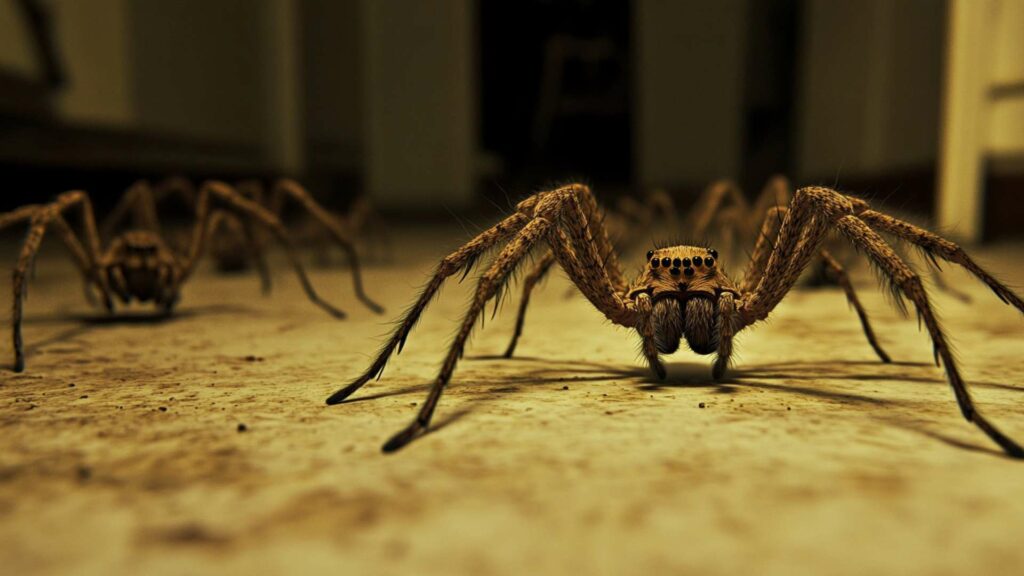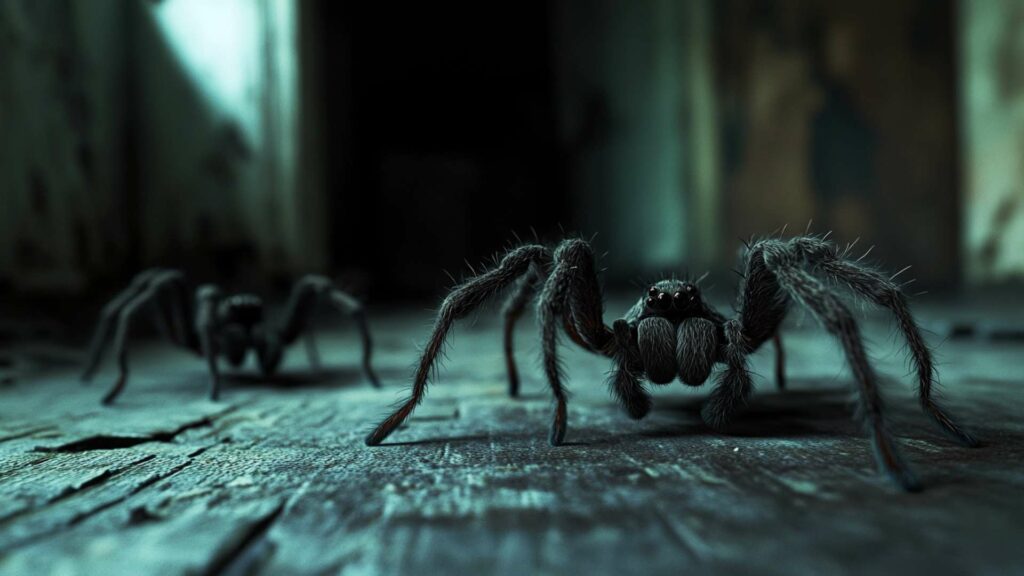Spiders—those eight-legged arachnids—are a constant source of fascination for many of us. They are mysterious creatures that can evoke both fear and awe in our hearts. From the intricate beauty of their webs to their incredible hunting techniques, spiders have captured our curiosity and become a subject of study for scientists and nature enthusiasts alike.
Fascination with Spiders

Why are we so captivated by these little critters? Well, it’s safe to say that spiders possess an undeniable allure.
Their unique appearance, with multiple eyes and long, slender legs, is enough to grab anyone’s attention. Some people are drawn to their impressive hunting skills; others are fascinated by their ability to create intricate webs that serve as both homes and traps for unsuspecting insects.
But there’s more than just aesthetics that makes spiders fascinating. These seemingly delicate creatures possess incredible strength and agility.
They can crawl up walls with ease, spin silk stronger than steel, and pounce on prey with lightning-fast reflexes. Despite their small size, some spiders—like diving spiders—not only swim but can also hold their breath underwater for extended periods of time.
Curiosity about Spider Behavior
Spiders’ behavior adds another layer to our fascination killing spiders. We wonder: Can they survive underwater?
Do they drown like other species? These questions arise from our natural curiosity about how different organisms adapt and interact with their environments.
If you’ve ever found a spider in your sink or caught one lingering too close to the shower drain, you might have wondered if it would meet its watery demise there. It’s not uncommon to think that these arachnids would simply drown when submerged in water or flushed down the toilet like other hapless creatures.
Spider anatomy and respiration
Spiders, like many other organisms, have their unique anatomical structures that enable them to survive in different environments. When it comes to respiration, spiders possess a fascinating system consisting of book lungs and tracheae. Book lungs are specialized respiratory organs that resemble the pages of a book, hence the name.
These structures are found in many spider species and function by extracting oxygen directly from the surrounding air. The tracheae, on the other hand, are tiny tubes that allow air to pass through the body, supplying oxygen to various organs and tissues.
Spider habitats and water encounters
While spiders generally prefer dry environments and while most spiders can be found in all corners of our homes creating intricate webs to catch prey, they can occasionally encounter water sources as well. Spiders usually seek out areas away from water since their exoskeletons are not naturally equipped to handle prolonged exposure. However, accidental encounters with water can occur due to rainstorms or being too close to sources such as sinks or bathtubs.
In these instances, spiders face potential death risks if they do not possess adaptations for survival in water. Overall, while spiders have mechanisms for surviving accidental encounters with water sources due to their adaptations such as hydrophobic exoskeletons and air bubble-trapping abilities, prolonged submersion is not ideal for them.
Spider Adaptations for Survival in Water

Water-repellent Exoskeletons
When it comes to spiders and water, their exoskeletons play a vital role in their survival. These remarkable creatures possess a unique adaptation that makes them highly resistant to water: hydrophobic hairs or setae.
Covering their entire bodies, these tiny hairs act as a natural waterproofing mechanism that repels water molecules. Picture a raindrop falling onto the back of a spider – instead of getting soaked and causing the spider to drown, it simply beads up and rolls off like it would on a freshly waxed car.
Surface Tension Exploitation
Another fascinating adaptation displayed by spiders trying to stay dry is the exploitation of water surface and tension. Surface tension is the cohesive force that allows insects like water striders to walk on water without sinking. Spiders have cleverly tapped into this life-saving phenomenon as well.
By distributing their weight effectively across the surface of standing or slow-moving water, they are able to effortlessly traverse areas that would otherwise submerge them. This technique is particularly useful for spiders encountered near ponds or small bodies of water.
Air Bubbles as Life-savers
In situations where spiders find themselves submerged underwater, they have developed ingenious methods to trap air bubbles and utilize them for survival. One method involves trapping air under their bodies using hydrophobic leg hairs. These specialized hairs retain air pockets against the side drown a spider’s body while underwater, allowing them to create an oxygen reservoir.
Effectively acting as temporary scuba tanks, these trapped air bubbles enable spiders to prolong their stay underwater without drowning. An even more remarkable approach employed by some aquatic spider and species involves creating an air bubble using silk threads.
When submerged, these spiders skillfully weave silk strands together near the water’s surface until they capture enough trapped air within the threads to float. Essentially crafting a tiny air-filled life raft, spiders can then cling to this bubble and stay afloat for extended periods.
This fascinating adaptation demonstrates the resourcefulness of these creatures in navigating unexpected water encounters. So, as it turns out, spiders have some pretty impressive adaptations that allow them to survive in water without drowning.
Their hydrophobic exoskeletons repel water, their ability to exploit surface tension keeps them from sinking, and they even have methods of trapping air bubbles to provide oxygen while submerged. The next time you come across a spider near a body of water, remember that they have their own remarkable strategies for staying alive and thriving in unexpected environments.
Spider Swimming Techniques
Paddling with Legs

When you think of a spider swimming, it may seem impossible or even comical. However, certain spider species have fascinating adaptations that allow them to navigate through the water.
One of their primary swimming techniques involves paddling with their legs. Despite their seemingly rigid exoskeletons, spiders possess remarkable flexibility in their limbs.
They can manipulate each leg independently, using a rowing motion to generate propulsion and move forward in the water. The flexibility of spider limbs plays a crucial role in their ability to swim effectively.
By bending and extending their legs in a coordinated manner, they create a series of synchronized movements resembling the actions of rowing oars. This motion generates small water currents that help push them forward, enabling them to maneuver underwater with surprising agility and grace.
Buoyancy through Silk Threads
In addition to leg paddling, some spiders employ an ingenious method of utilizing silk threads for buoyancy and floating on the water’s surface. These silk threads are not only used by spiders for creating elaborate webs but also play a role as life-saving devices when it comes to aquatic spiders surviving underwater encounters.
To create floating platforms, spiders weave multiple strands of silk together into a sort of raft or life preserver. By strategically attaching these silk strands to surrounding objects such as vegetation or rocks, they construct a buoyant structure capable of supporting their weight on the water’s surface.
This method allows spiders to remain suspended above the water rather than sinking beneath its surface. By using this clever technique effectively, they can conserve energy and avoid physical exhaustion while awaiting rescue or searching for an escape route.
Overall, these swimming techniques demonstrate how adaptable and resourceful spiders can be when faced with challenges posed by aquatic environments. From employing leg paddling motions akin to rowing through water currents to constructing buoyant platforms using silk threads, these incredible arachnids have honed their survival skills underwater.
Spider’s Endurance in Water
The Clock is Ticking When it comes to surviving in water, spiders have their limits just like any other living creature. How long a spider can withstand being submerged depends on various factors, including its species and age. Some species of spiders are more adapted to aquatic environments, while others are not as equipped to handle prolonged exposure to water. For example, water spiders or diving bell spiders have evolved with adaptations that allow them to survive underwater for extended periods. They construct air-filled chambers or “diving bells” using silk threads which they use as a sort of underwater home, enabling them to survive for several hours or even days. On the other hand, most land-dwelling spiders aren’t built for aquatic life and may struggle after just a few minutes underwater. Additionally, survival time in water can be influenced by external factors such as temperature and oxygen levels. Spiders are ectothermic creatures, meaning their body temperature is regulated by their environment rather than internally like humans. Lower temperatures can slow down their metabolism and extend their survival time underwater. However, if oxygen levels in the water are insufficient for gaseous exchange through the spider’s respiratory organs (such as book lungs or tracheae), then survival becomes even more challenging.
Detecting Danger and Swift Reactions Although spiders don’t possess specialized mechanisms solely dedicated to preventing drowning like aquatic creatures do, they have developed certain abilities that enhance their chances of survival when faced with imminent danger in water. Spiders possess an incredible sensitivity to vibrations in their surroundings, which enables them to detect disturbances caused by movements on the surface of the water or nearby objects falling into it. This acute awareness allows them to react quickly and attempt escape before succumbing to potential hazards. In some cases, spiders can detect vibrations on the water’s surface even before it ripples, giving them a valuable head start to avoid drowning. Moreover, spiders have impressively quick response times. When threatened by water, they exhibit remarkable agility and can rapidly propel themselves out of harm’s way using their flexible legs. This reflexive behavior helps them evade drowning and find refuge on dry land or any other suitable surface where they can reestablish their safety. It’s fascinating to consider these survival mechanisms that spiders possess as they navigate between their terrestrial homes and various forms of water encounters. While spiders may not be natural swimmers like fish or amphibians, their resilience and adaptability in the face of watery challenges showcase the intricate wonders of nature’s diverse creations.
Conclusion
Spiders’ Impressive Adaptability
Throughout this exploration of the underwater world of spiders, we have uncovered their remarkable adaptability. Despite being primarily terrestrial creatures, spiders have developed fascinating mechanisms to encounter and survive in water. Their ability to navigate through aquatic environments with grace and ingenuity is truly awe-inspiring.
One of the most impressive aspects of spider adaptability is their capacity to trap air bubbles and create temporary air reserves. By cleverly utilizing various techniques such as hydrophobic leg hairs or even spinning silk threads, these resourceful arachnids can sustain themselves underwater for surprisingly long periods.
Rather than succumbing to drowning easily like most other creatures, spiders manage to maintain buoyancy and glide through the water using their legs or by crafting floating platforms with silk. They not only rely on these air pockets for respiration but also use them strategically to make underwater webs to capture prey.
Appreciating the Wonders of Nature
The world of spiders serves as a captivating reminder that nature is an endless source of fascination and discovery. Often misunderstood or overlooked, these eight-legged creatures exhibit an array of astonishing abilities that challenge our preconceived notions about what is possible in the animal kingdom. The intricate adaptations they possess highlight the beauty and complexity found within even the smallest corners of our world.
By delving into topics such as spider respiration, swimming techniques, and drowning prevention mechanisms, we gain a deeper appreciation for the rich diversity present in nature’s designs. The fact that spiders have evolved such unique strategies to navigate aquatic environments fills us with wonderment at how life has adapted itself over millions of years.
So next time you encounter a spider scuttling across your house or bathroom floor or spinning its intricate web outside your window, take a moment to consider its incredible journey from land-dwelling ancestors to aquatic survivors. Embrace curiosity rather than fear, and marvel at the wonders that surround us — for within the smallest creatures lie extraordinary tales waiting to be unraveled.
Defeat Spiders with D-Termination: Las Vegas’ Leading Pest Control Solution!

If you’re worried about spiders invading your Las Vegas property, D-Termination provides the answer. Our skilled team specializes in eradicating spider infestations, restoring peace and tranquility to your space. Bid farewell to spiders—opt for D-Termination’s effective pest control today!
Contact us at 702-919-6310 or visit dtermination.com to schedule your spider control service and regain your space from these unwanted pests.
Frequently Asked Questions:
Some spiders can survive in water for a limited time.
Yes, spiders can die from drowning.
The maximum time a spider can live underwater varies by species but is usually limited.
Immersion in water or certain chemicals can kill a spider quickly.
If you found this article enjoyable, you might also find similar content appealing:
Fascinating Creatures with a Sense of Mystery: Can Spiders Smell?








